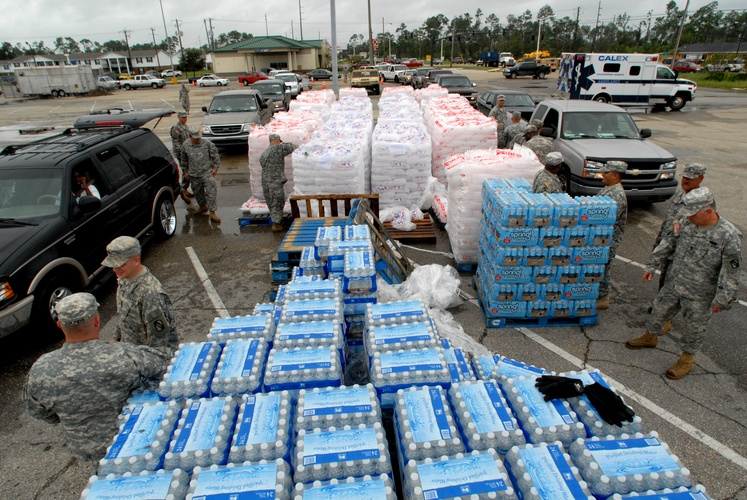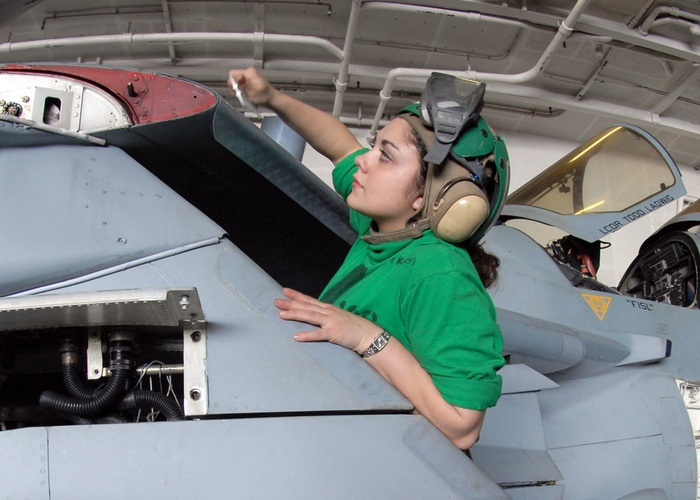The Oldest Aircraft in Military Service Still Flying Are Getting Old
The U.S. military has created perhaps the very best aircraft maintenance strategies the world has ever seen. How do we know this? Through a process known as phenomenology. Over the decades, phenomenology has shown how the U.S. military aviation branches have taken aircraft far beyond their expected service life and made them remain not only viable but cutting-edge.

But just how old are these aircraft? And how exactly does the military keep them reliably in the air, year after year? Let’s take a look at these dinosaurs of the air, how old they are, and what the U.S. military does to keep them viable and in the air.
Brief Overview of the Oldest Military Aircraft Still in Service
While all of the branches of the military have some fairly old aircraft, the United States Air Force definitely takes the cake for the oldest collection of military aircraft. The Air Force has certainly wrung just about everything it can get out of its fleet, with fighter jets that entered service immediately after Vietnam still in service.
Granted, most of those original examples have long since gone to rest in the high desert. But the designs soldier on.
The oldest designs still in service were drawn up shortly after World War II's end or during Korea's early years of the Cold War. These heavies were actually designed as complementary designs (the B-52 and KC-135). But these two stalwarts are not the only ancient designs in the fleet.
The Lockheed C-130 Herc has been hauling all kinds of stuff since the early ‘50s. We forget about that one, but it’s as old as the BUFF and the KC. And FRED, the amiable cargo giant C-5? Yeah, it first flew in 1968.
Importance of These Aircraft in Modern Military Operations
The crazy thing is that these archaic designs (and the other slew of old iron that we haven’t mentioned yet) still have a serious role in our national security that hasn’t changed much since they were introduced. Sure, Block upgrades, engine upgrades, and other updates have been added to these aircraft, but the airframes themselves remain unchanged.
The C-130 Hercules does basically the same mission it was designed to do in the 1950s, but it can do it with a much smaller crew (no need for a navigator or flight engineer in the latest updates)
Cold War Era (1940s-1960s)
It’s wild to think that the designers of the oldest designs still flying every single day in the United States Air Force were the same guys or contemporaries of World War II’s finest aeronautical engineers.
Yes, the oldest aircraft in the Air Force fleet are jets designed by many of the same designers as World War II aircraft.
Boeing KC-135 Stratotanker
The Boeing KC-135 Stratotanker has been in active service since 1957, which is particularly impressive because the first flight was in 1956. Our experience in World War II proved the point that a reliable aerial refueling mission was an absolute necessity. Our aerial campaigns were top notch, but range was always a key limiting factor (if not the limiting factor). You can either carry a lot of fuel or a lot of munitions, but it was hard to do both.

Aerial refueling allows bombers and fighters to take off with more munitions and less fuel, then hit an orbiting tanker shortly after takeoff to onload gas, and then hit tankers along the way to provide practically limitless range. The only limit to range is the aircrew and any mechanical issues.
The mission of the tanker has not changed at all, and the hardware required is still the same (the universal aerial refueling receptacle slipway installation, or UARRSI) has not changed in about seven decades.
In fact, and this is completely historically accurate, the boom on every single KC-135 today is identical to the first dedicated aerial tanker, the KC-97 Stratofreighter, a four-engine piston-powered airplane that was based on the infamous B-29 Superfortress.
Boeing RC-135/WC-135
We could have nested these under the KC-135 because they are derivatives of the same airframe, which has a common ancestor in the Boeing 707.
In fact, the most recent converts to WC-135 status were both KC-135 tankers in the Air National Guard until recently.
These jets are mostly stationed at Offutt Air Force Base in Omaha, Nebraska, and perform various tasks for spy missions and weather reconnaissance. They are the same age as the KC-135s since they are basically KC-135s, but that just goes to show how versatile and reliable an airframe it is.
Lockheed C-130 Hercules (1954)
The Herc, as it has been affectionately known for decades, is an older plane by all standards, one of the oldest in service today. The KC-135 and the B-52 get all of the attention for being old, but the Herc was right there with them in the first days of the Cold War. In fact, the Korean War was barely concluded when the Herc entered service.
One thing we knew to be a key component of effective ground campaigns was reliable and effective cargo support, and while the C-47 and its ilk served admirably, it was sorely lacking in terms of altitude, duration, and capacity. In fact, all piston-powered cargo aircraft we lacking. The engines are incredibly heavy and complicated for the power produced, and the advent of the jet age also showed that turbines are tremendous for propellor-powered aircraft. Light, simple, and incredibly reliable, as well as quiet and smooth, they were a natural progression.
The Herc was a very early adopter of turboprop power, one of the earliest to be designed specifically for turbine power rather than a retrofit, and has been to about as many countries as are on the map.
The Herc is so useful that all branches of the U.S. military operate it except for the Army.

Boeing B-52 Stratofortress (1955)
Now, we come to the BUFF, perhaps the most iconic aircraft in service. Boeing designed this absolute monster almost 75 years ago, and then designed the KC-135 a couple years later to fuel it.
The BUFF was designed for nuclear missions in the early days of the Cold War, yet it has only ever dropped conventional munitions. And here’s the crazy part: the United States Air Force anticipates the Boeing B-52 will remain in service until around 2060. That’s right, it will pass the century mark before it finally gets a break.
Northrop T-38 Talon (1959)
In an interesting case of egg and chicken, here we have the Northrop T-38 Talon. Nobody really considers the age of this aircraft, but they should. Regardless of track, it was designed to be the secondary trainer for all Air Force UPT candidates. Whether you were going bombers, fighters, cargo, tankers, or any other aircraft, you got to ride the lightning in the Talon.
It wouldn’t be until the 1990s that the T-1 Jayhawk was introduced for pilots who were not going in fighter, attack, or bomber tracks.
The Air Force has scheduled a replacement for the T-38, but it is still a few years out, so the venerable Talon soldiers on in a few different roles, including training all fighter, attack, and bomber-track students.
CH-47 Chinook
Rounding out the Cold War era aircraft is the premier heavy-lift helicopter in the U.S. Army, the CH-47 Chinook. Now-defunct Vertol designed the Chinook in the late 1950s, with the first flight in 1961 and entering service in 1962. It’s hard to think that the Chinook has been around for 62 years, but it has, and it is still just as relevant now as it was in the early 60s.
Modern Era (1970s-1980s)
As impressive as it is that we are still operating so many aircraft from the early stages of the Cold War, it is almost more impressive that so many fighter jets from the late Vietnam era are still at it, especially fighter aircraft. Operating combat aircraft daily under the stresses that fighter aircraft are subjected to is impressive. All of the fighter jets in this list cut their teeth in the Persian Gulf War over three decades ago and are still some of the premier fighter jets in the world.
General Dynamics F-16 Fighting Falcon (1974)
The F-16 Viper remains the most prolific ground attack and fighter aircraft in the Air Force today, with over one thousand in the inventory. It is also one of the most common fighter aircraft in the world, with at least 25 nations operating it and more nations requesting access to the Viper.
The ITAR is the governing regulation for foreign operators, and FMS is the vehicle used to conduct the sales, both of which are our expertise.
McDonnell Douglas F-15 Eagle (1972)
Another favorite jet of American forces and other countries is the F-15 Eagle. The Eagle has been the U.S.’s frontline air superiority champion since the 70s, which is incredible and probably won’t ever be topped by any other aircraft. It is undefeated in aerial combat and soldiers on despite its advanced age.
Fewer foreign operators use the Eagle than the F-16, largely because the Eagle is a one-dimensional aircraft: it is only used for air superiority. The F-16 is appealing because it costs less to operate and acquire and is made for dual roles. But for nations that have legitimate air-to-air concerns (Israel), the Eagle is unmatched.

Beechcraft C-12 Huron (1974)
While it certainly operates on a different level than the fighters above, the C-12 Huron has an impressive service record. For one thing, it has been in service for five decades, which is remarkable. But it has also been used for all kinds of jobs.
The RC-12 Guardrail is the Army’s long-standing aerial reconnaissance platform, having served almost as long as the Huron.
The Army has long planned to replace the Huron with a more modern option, but the project continues to get shelved for budgetary reasons. It’s hard to argue that the priority would be higher if the Huron weren’t so utterly reliable.
Final Thoughts
The United States military is the most impressive in history; the USAF is the largest air force in the world, while the U.S. Navy is the second largest air force in the world.
Even though the fleet is getting really old, our forces are the premier aerial fighting forces the world has ever seen.
Superior maintenance practice is the reason for this and the reason these old airframes will continue to reign supreme for many years to come. Greenwood Aerospace will ensure that the military fleets get the parts they need, when they need them, to stay in the fight or to train the next generation of pilots.
Give us a call at (580) 762-2580, or get an online quote started today!


.svg)


.png)


